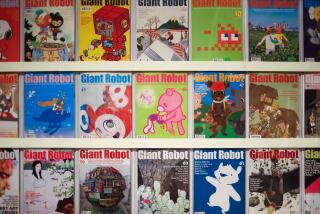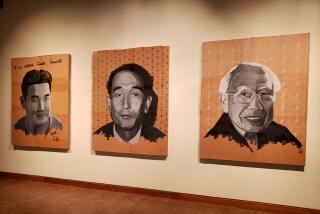A Traditional Craft Whittled Away by the Imagination
- Share via
SANTA ANA — People inevitably marvel over the skill involved in making tiny objects and the adorable quality of miniature imagery. So it’s no wonder that the minuscule Japanese amulets called netsuke--redolent of cultural lore and exquisitely carved from valuable materials, often ivory--appeal to Western viewers.
Netsuke were traditionally used by Japanese men as a toggles for the cords suspending containers that held their personal accessories--a necessity because kimonos had no pockets.
Although there’s no practical need for netsuke anymore, contemporary carvers, whose work is represented in the Bowers Museum show “Contemporary Netsuke: Miniature Sculptures From Japan and Beyond,” have been making the little pieces as demonstrations of skill and imaginative fancy, substituting such materials as boxwood and tagua nuts for ivory, banned as an export in 1989.
But in attempting to reanimate a traditional craft, they frequently have drained it of the aspects that account for its relevance and charm.
The exhibition, the second of two installments, is organized loosely by subject--zodiac animals; gods, saints and sages; legends and folk tales, and so forth. Traditional netsuke categories seem beside the point, however, in a global, contemporary context. Why should European or American carvers--or Japanese artists, for that matter--confine themselves to themes that may mean nothing to them?
*
One of the most peculiar homages to Japanese history is the cartoonish image of a Dutchman carved by Englishman Michael Birch.
It is, of course, based on 19th century woodcuts by Japanese artists who marveled at the big-nosed Dutch merchants, the first foreigners to breach Japan’s pre-1858 insulation from the outside world. But the charm of the originals is based on the authenticity of the artists’ reactions. For a modern-day Westerner to work without any apparent sense of irony in this style is hardly much different from a contemporary African American studiously copying an Aunt Jemima figure.
Stylistically, there’s an overwhelming sense of deja vu here for anyone familiar with netsuke. Many artists turn out intricate showpieces in the traditional manner (a wasps’ nest; a demon in a bean pod; Daruma, the Zen Buddhist missionary, showing two tiny teeth as he yawns). A cynic might wonder if such pieces mainly serve the needs of collectors unable to afford originals.
*
Alas, the few who depart from this model tend to produce cuteness of the Lladro figurine variety or pieces in a syrupy or cloyingly decorative style (a bundle of love letters with one edge carefully “charred”; an evocation of winter with gold-etched branches and tiny pearls).
“Contemporary Netsuke” is crowd-pleasing filler at best, occupying a shaky niche between historical carvings and contemporary kitsch. Once again, the Bowers’ attempt to present “art” founders because of its lack of scholarly commitment, to art or culture.
* “Contemporary Netsuke, Miniature Sculpture From Japan and Beyond” (open indefinitely). Bowers Museum of Cultural Art, 2002 N. Main St., Santa Ana. Hours: 10 a.m.-4 p.m. Tuesday, Wednesday and Friday-Sunday; 10 a.m.-9 p.m. Thursday. Admission: $6 general; $4 students and seniors; $2 children 5-12, free for under 5. (714) 567-3600.
More to Read
The biggest entertainment stories
Get our big stories about Hollywood, film, television, music, arts, culture and more right in your inbox as soon as they publish.
You may occasionally receive promotional content from the Los Angeles Times.










